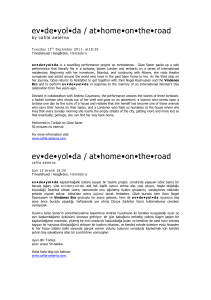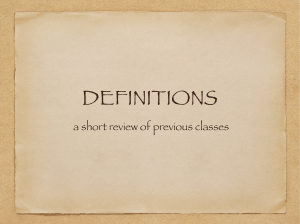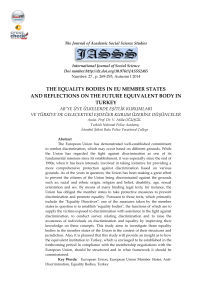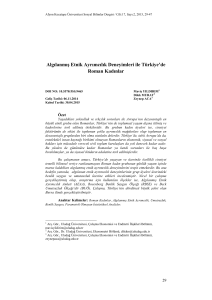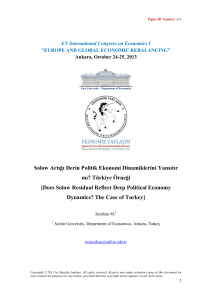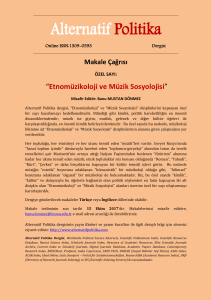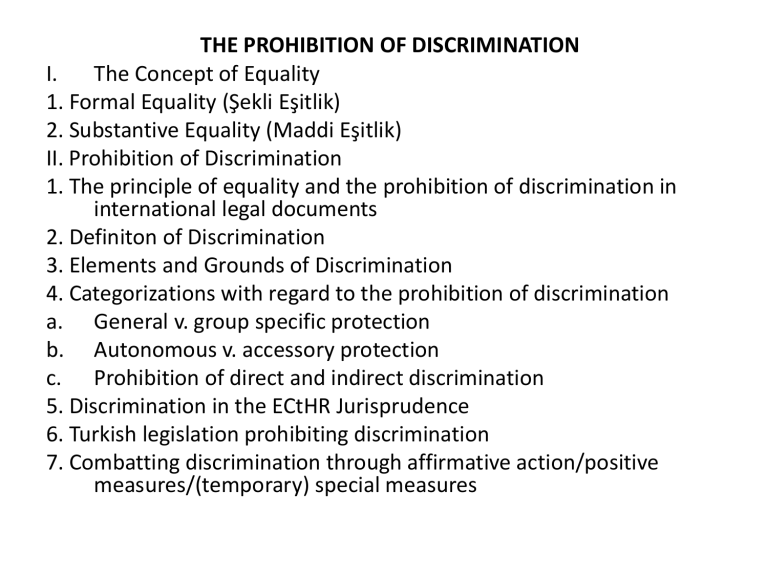
THE PROHIBITION OF DISCRIMINATION
I.
The Concept of Equality
1. Formal Equality (Şekli Eşitlik)
2. Substantive Equality (Maddi Eşitlik)
II. Prohibition of Discrimination
1. The principle of equality and the prohibition of discrimination in
international legal documents
2. Definiton of Discrimination
3. Elements and Grounds of Discrimination
4. Categorizations with regard to the prohibition of discrimination
a. General v. group specific protection
b. Autonomous v. accessory protection
c. Prohibition of direct and indirect discrimination
5. Discrimination in the ECtHR Jurisprudence
6. Turkish legislation prohibiting discrimination
7. Combatting discrimination through affirmative action/positive
measures/(temporary) special measures
Preliminary Question: Why is the principle of non-discrimination vital for
the protection of human rights, and thus, for our lecture?
•The prohibition of discrimination is the negative restatement of the
principle of equality.
•The universality of human rights is based on the premise that all people
are born “free and equal in dignity and rights”.
UDHR (1948), Preamble: “Whereas recognition of the inherent dignity
and of the equal and inalienable rights of all members of the human
family is the foundation of freedom, justice and peace in the world,…”
Art. 1: “All human beings are born free and equal in dignity and
rights.They are endowed with reason and conscience and should act
towards one another in a spirit of brotherhood.”
•Equality is the cornerstone of all democratic States – equality of
persons before the law, equality of opportunity, equality of access to
education
•Principle of equality and the prohibition of discrimination is the
precondition for all other human rights to be applied effectively.
• A perspective regarding the status of men and women:
http://fgulenyazilari.blogcu.com/kadin-erkek-birbirine-esitmidir/3224062
• To say that human beings are equal is not to say they are identical.
The postulate of equality implies that underneath apparent
differences, certain recognizable entities or units exist that, by dint of
being units, can be said to be ‘equal.’ (Thomson 1949, p. 4).
Fundamental equality means that persons are alike in important
relevant and specified respects alone, and not that they are all
generally the same or can be treated in the same way (Nagel 1991). In
a now commonly posed distinction, stemming from Dworkin (1977, p.
370), moral equality can be understood as prescribing treatment of
persons as equals, i.e., with equal concern and respect, and not the
often implausible principle of treating persons equally. This
fundamental idea of equal respect for all persons and of the equal
worth or equal dignity of all human beings (Vlastos 1962) is accepted
as a minimal standard by all leading schools of modern Western
political and moral culture. Any political theory abandoning this notion
of equality will not be found plausible today. moral equality
constitutes the ‘egalitarian plateau’ for all contemporary political
theories (Kymlicka 1990, p.5).
I.
The Concept of Equality
1. Formal Equality:
•Formal equality simply suggests that likes must be treated alike, a principle
that Aristotle formulated in reference to Plato (Aristotle, Nicomachean Ethics,
V.3. 1131a10-b15; Politics, III.9.1280 a8-15, III. 12. 1282b18-23). So, “equality
before the law” means first and foremost that the law should apply to all
persons in an equal and consistent manner (EU Charter, Justice Commentary).
•This approach is reflected in the concept of less favourable treatment, namely,
direct discrimination.
Şekli eşitlik: Herkesin, tüm verili koşullarıyla eşit olduğu varsayımından yola
çıkan, eşit durumda olanların eşit muamele görmesini ve ayrımcılık yapılmadığı
sürece mevcut durumun korunmasını eşitliğin varlığı için yeterli sayan eşitlik
anlayışı. (Ayrımcılık Yasağı, Gül ve Karan, s. 6)
•This formal principle is reasoned with two different perspectives: a specific
application of a rule of rationality, and a moral principle of justice, basically
corresponding with acknowledgement of the impartial and universalizable
nature of moral judgments. So what matters is not the consistency with one’s
subjective demands, a possible justification of the equal or unequal treatment
vis-à-vis others should be made, and the treatment should be evaluated on the
situation’s objective features. (Stanford Ensyclopedia of Philosophy)
Q: Any defects of this approach? Does an equal treatment always purport to an
equal outcome?
2. Substantive equality (Moral Equality):
•Until the eighteenth century, it was assumed that human beings are unequal
by nature and therefore, that there was a natural human hierarchy. This
understanding collapsed with the advent of the idea of natural right and its
assumption of an equality of natural order among all human beings. This idea
was accompanied by the presumption that everyone deserved the same
dignity and the same respect. This proposition gave birth to the widely held
conception of substantive, universal, moral equality.
•A legal approach: ‘Substantive equality’ is a conception of equality that is
concerned with the ensuring ability of persons to compete on an equal basis,
having regard to various obstacles that may impede this equality of
opportunity.
•Substansive equality is a departure from classic or formal equality (or treating
likes alike) and from equal treatment (ensuring that laws or policies apply to
everyone in the same way). Substantive equlity is concerned that laws and
customary practices do not diminish anyone’s access to societal goods or
perpetuate discrimination. The aim of substantive equality analysis is to use
law to remedy past and present disadvantage by examining the context or
“lived-experiences” of those to whom equality in result is due.
Maddi Eşitlik: Kişi ve kişi grupları arasındaki farklılıkları olumlu yönde göz
önünde bulunduran ve onları eşit veya aynı varsaymayan eşitlik anlayışı. Bu
sayede mevcut eşitsizlikleri ortadan kaldırmak için geçici özel önlemler gibi
önlemler gündeme gelebilmektedir. (Gül, Karan, s. 7)
(See slides on Affirmative Action)
2. Substantive Equality
• In particular, claims of ‘substantive equality’ seek to
highlight significant social obstacles (particularly
discrimination based on social characteristics) to equal
access to such goods as education, employment, goods
and services.
• For instance, an unequal distribution of childcare
responsibilities between women and men may make it
more difficult for women with children to undertake jobs
with long working hours without additional support or
accommodation. Accordingly, merely eliminating sex
discrimination on the hiring stage may not be enough to
ensure that female workers have the same employment
opportunities as male workers. It suggests that it may be
necessary to take further steps to accommodate or assist
female workers with children so that they may compete
on equal terms with their male counterparts.
• More on the significance of the principle of equality for human rights:
excerpts from the South West Africa Case before the ICJ (Ethiopia v. South
Africa; Liberia v. South Africa, 18 July 1966) and the Dissenting opinion of
Judge Tanaka:
“ Examining the principle of equality before the law, we consider that it is
philosophically related to the concepts of freedom and justice. The freedom
of individual persons, being one of the fundamental ideas of law, is not
unlimited and must be restricted by the principle of equality allotting to each
individual a sphere of freedom which is due to him. In other words the
freedom can exist only under the premise of the equality principle. In what
way is each individual allotted his sphere of freedom by the principle of
equality? What is the content of this principle? The principle is that what is
equal is to be treated equally and what is different is to be treated differently,
namely proportionately to the factual difference. This is what was indicated
by Aristotle as justitia commutativa and justitia distributiva.
The most fundamental point in the equality principle is that all human beings
as persons have an equal value in themselves, that they are the aim itself and
not means for others, and that, therefore, slavery is denied. The idea of
equality of men as persons and equal treatment as such is of a metaphysical
nature. It underlies all modern, democratic and humanitarian law systems as
a principle of natural law. This idea, however, does not exclude the different
treatment of persons from the consideration of the differences of factual
circurmstances such as sex, age, language, religion, economic condition,
education, etc. To treat different matters equally in a mechanical way would
be as unjust as to treat equal matters differently.” (p. 303)
“We can say accordingly that the principle of equality before the law does not
mean the absolute equality, namely equal treatment of men without regard to
individual, concrete circumstances, but it means the relative equality, namely
the principle to treat equally what are equal and unequally what are unequal.
The question is, in what case equal treatment or different treatment should
exist. If we attach importance to the fact that no man is strictly equal to
another and he may have some particularities, the principle of equal
treatment could be easily evaded by referring to any factual and legal
differences and the existence of this principle would be virtually denied. A
different treatment comes into question only when and to the extent that it
corresponds to the nature of the difference. To treat unequal matters
differently according to their inequality is not only permitted but required. The
issue is whether the difference exists. Accordingly, not every different
treatment can be justified by the existence of differences themselves, namely
that which is called for by the idea of justice –‘the principle to treat equal
equally and unequal according to its inequality, constitutes an essential
content of the idea of justice’ (Goetz Hueck, Der Grundsatz der
Gleichmeassigen Behandlung in Privatrecht, 1958, p. 106).”
“…the principle of equality being in the nature of natural law and therefore of
a supra-constitutional character, is placed at the summit of hierarchy of the
system of law, and all positive laws including the constitution shall be in
conformity with this principle.” (p. 304)
1.
II. Discrimination
The principle of equality and the prohibition of discrimination in international
legal documents
UN CHARTER
PREAMBLE
“WE THE PEOPLES OF THE UNITED NATIONS DETERMINED…. to reaffirm faith in
fundamental human rights, in the dignity and worth of the human person, in the
equal rights of men and women and of nations large and small, and…”
CHAPTER I: PURPOSES AND PRINCIPLES
Article 1
“The Purposes of the United Nations are: …
2. To develop friendly relations among nations based on respect for the principle of
equal rights and self-determination of peoples, and to take other appropriate measures
to strengthen universal peace;
3.
To achieve international co-operation in solving international problems of an
economic, social, cultural, or humanitarian character, and in promoting and encouraging
respect for human rights and for fundamental freedoms for all without distinction as to
race, sex, language, or religion; and…”
Other Articles : Art. 8 (equality), Art. 13, 55, 76 (without distinction to…)
1.
The principle of equality and the prohibition of discrimination in
international legal documents
UN INTERNATIONAL CONVENTION ON CIVIL AND POLITICAL RIGHTS
Article 26
All persons are equal before the law and are entitled without any
discrimination to the equal protection of the law. In this respect, the law shall
prohibit any discrimination and guarantee to all persons equal and effective
protection against discrimination on any ground such as race, colour, sex,
language, religion, political or other opinion, national or social origin, property,
birth or other status.
Madde 26
Herkes yasa önünde eşittir ve herhangi bir ayrımcılık gözetilmeksizin
yasanın eşit şekilde koruması hakkına sahiptir. Bu bağlamda, yasa herhangi bir
ayrımcılığı yasaklayacak ve ırk, renk, cinsiyet, dil, din, siyasal ya da diğer görüş,
ulusal ya da toplumsal köken, mülkiyet, doğum ya da başka bir statü gibi
herhangi temeldeki bir ayrımcılığa karşı tüm kişilerin etkili ve eşit biçimde
korunmasını güvence altına alacaktır.
*In the official translation, “ayrım gözetilmeksizin” is used, although it is seen
that Art. 2 and Art. 25 uses the wording “distinction”; whereas this article uses
“discrimination”. The official translation neglects the difference in the wording
of the articles.
1. The principle of equality and the prohibition of
discrimination in international legal documents
Other Conventions entailing the prohibition of discrimination:
• Genocide Convention (1948)
• Convention Relating to the Status of Refugees (1951)
• International Convention relating to the Status of Stateless
Persons (1954)
• International Convention on the Suppression and Punishment
of the Crime of Apartheid (1973)
• Additional Protocol (1977) to the Geneva Conventions on the
Protection of Victims of International Armed Conflicts
• The Convention Against Torture and Other Cruel, Inhuman or
Degrading Treatment or Punishment (1984),
• International Convention against Apartheid in Sports (1985)
• Convention on the Rights of the Child (1989)
2.
Definition of Discrimination
•
At its core, discrimination is “treating differently, without an objective and
reasonable justification, persons in relevantly similar situations” (ECtHR, Willis v.
UK, 2002, para 48; Zarb Adami v. Malta, 20.06.2006)
- International law conceptualizes discrimination as unjustified debasement of
individuals on the grounds of identity-related characteristics and embodies several
approaches and categories of prohibitions to discriminate.
Legal definitons of discrimination:
•International Convention on the Elimination of All Forms of Racial
Discrimination(1965):
Art.1: In this Convention, the term "racial discrimination" shall mean any distinction,
exclusion, restriction or preference based on race, colour, descent, or national or ethnic
origin which has the purpose or effect of nullifying or impairing the recognition,
enjoyment or exercise, on an equal footing, of human rights and fundamental freedoms
in the political, economic, social, cultural or any other field of public life.
Madde 1: Bu Sözleşmede “ırksal ayrımcılık” terimi, siyasi, ekonomik, sosyal, kültürel
alanda ya da kamusal yaşamın herhangi bir başka alanında, eşitlik temelinde olarak,
insan haklarının ve temel özgürlüklerin tanınmasını, bunlardan yararlanılmasını yahut
bunların kullanılmasını kaldırmak yahut zayıflatmak amacını taşıyan ya da etkisini
doğuran (ve) ırk, renk, soy ya da ulusal yahut etnik kökene dayanan herhangi bir farklılık
gözetme, dışlama, kısıtlama yahut öncelik tanıma/tercihte bulunma anlamına gelecektir.
2. Definition of Discrimination
• Convention on the Elimination of All Forms of Discrimination Against Women
(1979):
Art. 1:
For the purposes of the present Convention, the term "discrimination
against women" shall mean any distinction, exclusion or restriction made on
the basis of sex which has the effect or purpose of impairing or nullifying the
recognition, enjoyment or exercise by women, irrespective of their marital
status, on a basis of equality of men and women, of human rights and
fundamental freedoms in the political, economic, social, cultural, civil or any
other field.
Madde 1:
Bu Sözleşmenin amaçları bakımından “kadınlara karşı ayrımcılık” terimi,
kadınların medeni durumları her ne olursa olsun, siyasal, ekonomik, sosyal,
kültürel, medeni ya da herhangi bir başka alanındaki insan haklarının ve
temel özgürlüklerin, erkekler ve kadınlar arasında eşitlik temelinde olarak,
kadınlara tanınmasını, kadınlar tarafından bunlardan yararlanılmasını yahut
kullanılmasını zayıflatma (azaltma) yahut hükümsüz kılma etkisini doğuran ya
da bu amaca yönelen, cinsiyete dayalı herhangi bir farklılık gözetme, dışlama,
ya da kısıtlama anlamına gelecektir.
3. Elements and Grounds of Discrimination in International Legal
Documents:
•Elements:
1. Distinction (farklılık gözetme)
2. Exclusion (dışlama)
3. Restriction (kısıtlama/sınırlama)
4. Preference (öncelik tanıma)
•Grounds (see suspect qualifications)
-race, colour, sex, language, religion, political or other opinion, national
or social origin, property, birth or other status (ICCPR art. 2/1, art. 26;
ICESCR art. 2/2)
-race, colour, descent, or national or ethnic origin (IAOKS, art. 1)
-economic condition – inter alia- (UNESCO, Conv. Against Discrim. in
Education)
-disability –inter alia- (Convention on the Rights of the Child)
Q: Is there a hierarchy among these grounds?
4. Categorizations with regard to the prohibition
of discrimination
a. General v. group specific protection: Group specific prohibitions of
discrimination are applicable to particular categories of persons. E.g.
International Convention on the Elimination of All Forms of Discrimination,
CEDAW, Convention on the Rights of Persons with Disabilities of 2006, ILO
Conventions
b. Autonomous v. accesory protection
Art. 26 of the ICCPR is the only provision of a universal treaty that affords this
form of autonomus all-embracing protection against discrimination. 14th Article
of the ECHR suggests an accessory protection, whereas the 12th Protocol of the
ECHR provides an autonomous protection at the regional level.
PROTOCOL 12, ARTICLE 1
General prohibition of discrimination
1. The enjoyment of any right set forth by law shall be secured
without discrimination on any ground such as sex, race, colour,
language, religion, political or other opinion, national or social
origin, association with a national minority, property, birth or
other status.
2. No one shall be discriminated against by any public authority
on any ground such as those mentioned in paragraph 1.
Ayrımcılığın genel olarak yasaklanması
1. Hukuken temin edilmiş olan tüm haklardan yararlanma,
cinsiyet, ırk, renk, dil, din, siyasi veya diğer kanaatler, ulusal ve
sosyal köken, ulusal bir azınlığa mensup olma, servet, doğum
veya herhangi bir diğer statü bakımından hiçbir ayrımcılık
yapılmadan sağlanır.
2. Hiç kimse, 1. paragrafta belirtildiği şekilde hiçbir gerekçeyle,
hiçbir kamu makamı tarafından ayrımcılığa maruz bırakılamaz.
ARTICLE 14
The enjoyment of the rights and freedoms set
forth in this Convention shall be secured without
discrimination on any ground such as sex, race,
colour, language, religion, political or other opinion,
national or social origin, association with a national
minority, property, birth or other status.
Ayrımcılık yasağı
Bu Sözleşme'de tanınan hak ve özgürlüklerden
yararlanma, cinsiyet, ırk, renk, dil, din, siyasal veya
diğer kanaatler, ulusal veya toplumsal köken, ulusal
bir azınlığa aidiyet, servet, doğum başta olmak üzere
herhangi başka bir duruma dayalı hiçbir ayrımcılık
gözetilmeksizin sağlanmalıdır.
c. Direct v. indirect discrimination
•Direct discrimination occurs where an adverse
distinction in legislation or in the application of a
basically non-discriminatory law is directly related to
one of the prohibited grounds of distinction without
adequate objective justification.
•Doğrudan ayrımcılık: Burada aynı veya benzer
konumdaki kişilerden biri veya bir kısmı bakımından
daha olumsuz sonuçlar yaratan veya böyle bir
sonucun ortaya çıkması ihtimalini doğuran farklı
muameleler söz konusudur.
•http://web.hurriyetdailynews.com/n.php?n=turkeymust-take-action-over-lgbt-discrimination-ai-reportsuggests-2011-06-20
c. Direct v. indirect discrimination
•Indirect discrimination: Laws or their application may result in
distinctions that, though unrelated to any prohibited grounds,
in practice have detrimental effects that exclusively or at least
disproportionately affect people with such characteristics.
•“A general policy or measure that has disproportionately
prejudicial effects on a particular group may be considered
discriminatory notwithstanding that it is not specifically aimed
at that group … and that discrimination potentially contrary to
the Convention may result from a de facto situation.” (ECtHR,
D.H. and others v. Czech Republic, 7.2.2006)
•Dolaylı ayrımcılık: Herkes için aynı şekilde geçerli ve görünüşte
tarafsız olan, ancak bazı kişi ve gruplar üzerinde diğerlerinden
farklı olarak veya diğer gruplardan daha fazla olumsuz etkiler
yaratan yasal düzenleme, uygulama ve tedbirler.
Q: Why do we even make this distinction?
5. Discrimination in the ECtHR Jurisprudence
Steps pursued by the Court to decide on the
violation of Article 14
①Designating the Convention article whose ambit
Article 14 falls within
②Deciding whether there was a difference of
treatment between the applicant and others
③Deciding if these persons were in ‘analogous
situations’
④Deciding whether there is an objective and
reasonable justification for the difference of
treatment (add. to the formulation: pursuing a
legitimate aim, proportionality relationship between
the means employed to the aim pursued) (see
Rasmussen v. Denmark (28.11.1984))
5. Discrimination in the ECtHR Jurisprudence
①The ambit test:
In terms of the parasitic nature of the article, there is no need to show or
claim violation of another article, ‘falling within the ambit of a Convention
right’ suffices. This is called the “ambit test approach”.
see Belgian Linguistic Case (23.07.1968):
“In its opinion of 24th June 1965, the Commission expressed the view that
although Article 14 (art. 14) is not at all applicable to rights and freedoms not
guaranteed by the Convention and Protocol, its applicability "is not limited to
cases in which there is an accompanying violation of another Article". In the
view of the Commission "such a restrictive application" would conflict with the
principle of effectiveness established by the case law of the Permanent Court
of International Justice and the International Court of Justice, for the
discrimination would be limited to the aggravation "of the violation of another
provision of the Convention…”
If a State goes beyond its obligation under a Convention right, it has to do
this in a non-discriminatory manner. (textbook, p. 548)
Egs. Right to adopt is not protected under art. 8, however, French law enables
single persons to adopt, so what if a single homosexual is denied adoption?
5. Discrimination in the ECtHR Jurisprudence
Case of E.B. v. France (2008):
“91. The Court reiterates that, for the purposes of Article 14, a
difference in treatment is discriminatory if it has no objective
and reasonable justification, which means that it does not
pursue a “legitimate aim” or that there is no “reasonable
proportionality between the means employed and the aim
sought to be realised” (see, inter alia, Karlheinz Schmidt, cited
above, § 24; Petrovic, cited above, § 30; and Salgueiro da Silva
Mouta, cited above, § 29). Where sexual orientation is in issue,
there is a need for particularly convincing and weighty reasons
to justify a difference in treatment regarding rights falling
within Article 8 (see, mutatis mutandis, Smith and Grady v. the
United Kingdom, nos. 33985/96 and 33986/96, § 89, ECHR
1999-VI; Lustig-Prean and Beckett v. the United Kingdom, nos.
31417/96 and 32377/96, § 82, 27 September 1999; and S.L. v.
Austria, no. 45330/99, § 37, ECHR 2003-I).”
5. Discrimination in the ECtHR Jurisprudence
②Differential treatment on a prohibited ground:
- The list is not exhaustive.
The difference of treatment has to be explained in terms
of personal characteristics – What is precisely meant
by personal characteristic is not always easy to
determine. Eg. The Court did not accept the
geographical location where the applicant was
detained (Magee v. UK at O’Boyle, p. 585); residence of
a person, like nationality, however, falls within the
scope of this (Carson and others v. UK in textbook, p.
551)
• Examples of “other status”: sexual orientation, marital
status, country of domicile or residence, the suffering
from the psychological harm caused by child abuse”
5. Discrimination in the ECtHR Jurisprudence
③Being in similar situations
The Court often passes this step and starts
discussing whether there can be a justification for
the differentiation.
•Persons whose situations are significantly
different should be treated differently. Eg.
Thlimmenos v. Greece, 6.5.2000 – a Jehova’s
witness being convicted because of not serving in
the army and excluded from a profession as a
result
5. Discrimination in the ECtHR Jurisprudence
④ Objective and reasonable justification
Unless there is a common European standard, the
Court will less probably condemn the differentiation.
Eg. Rasmussen v. Denmark (28.11.1984):
“The scope of the margin of appreciation will vary
according to the circumstances, the subject-matter
and its background; in this respect, one of the
relevant factors may be the existence or nonexistence of common ground between the laws of
the Contracting States.” (para. 40)
See Sidabras and Dziautas v. Lithuania (7.5.2005) –
the KGB agents case - here there was no reasonable
justification as to the different treatment.
5. Discrimination in the ECtHR Jurisprudence
Intensive scrutiny of differential treatment for
‘suspect categories’
• Very weighty reasons are required to justify the
different treatment, and the margin of
apprication of the State is pretty narrow in
terms of some grounds, as observed in the
ECtHR jurisprudence. There grounds are:
- Race or ethnic origin, nationality, sex,
legitimacy, religion
5. Discrimination in the ECtHR Jurisprudence
• Racial discrimination
- The Court has indicated that discrimination on grounds of ethnicity is a form
of racial discrimination – see Secic v. Croatia: A Croatian of Roma origin who
was attacked and injured, where his attackers shouted at him assaulting his
ethnic origin while attacking him.
• Minorities and discrimination:
- DH v. Czech Republic (13.11.2007) : Special schools where predominantly
kids of Roma origin attend – violation of Art. 14 in conjunction with Art. 2 of
Protocol 1.
• Discrimination based on sexual orientation
- Smith and Grady v. UK (27.9.1999) constitutes a landmark case.
- The first time right after this case, where the Court found a violation of Art.
14 in conjunction with Art. 8 in terms of sexual orientation is Salguiero da
Silva Mauta v. Portugal (21.12.1999) – rejection of awarding parental
responsibility to the father, his homosexuality being a decisive factor
- Another important eg. İs EB v. France, where a lesbian was denied from
adoption as a single mother.
6. Turkish Legislation Prohibiting Discrimination
ANAYASA
X. Kanun önünde eşitlik
MADDE 10- Herkes, dil, ırk, renk, cinsiyet, siyasî düşünce, felsefî inanç,
din, mezhep ve benzeri sebeplerle ayırım gözetilmeksizin kanun
önünde eşittir.
(Ek fıkra: 7/5/2004-5170/1 md.) Kadınlar ve erkekler eşit haklara sahiptir.
Devlet, bu eşitliğin yaşama geçmesini sağlamakla yükümlüdür. (Ek
cümle: 12/9/2010-5982/1 md.) Bu maksatla alınacak tedbirler eşitlik
ilkesine aykırı olarak yorumlanamaz.
(Ek fıkra: 12/9/2010-5982/1 md.) Çocuklar, yaşlılar, özürlüler, harp ve
vazife şehitlerinin dul ve yetimleri ile malul ve gaziler için alınacak
tedbirler eşitlik ilkesine aykırı sayılmaz.
Hiçbir kişiye, aileye, zümreye veya sınıfa imtiyaz tanınamaz.
Devlet organları ve idare makamları bütün işlemlerinde kanun önünde
eşitlik ilkesine uygun olarak hareket etmek zorundadırlar. (*)
* 9/2/2008 tarihli ve 5735 sayılı Kanunun 1 inci maddesiyle; bu fıkraya
“bütün işlemlerinde” ibaresinden sonra gelmek üzere “ve her türlü
kamu hizmetlerinden yararlanılmasında” ibaresi eklenmiş ve bu ibare
Anayasa Mahkemesinin 5/6/2008 tarihli ve E.: 2008/16, K.: 2008/116
sayılı Kararı ile iptal edilmiştir. (R.G.: 22/10/2008, 27032)
6. Turkish Legislation Prohibiting Discrimination
TCK
Adalet ve kanun önünde eşitlik ilkesi
MADDE 3.
(1) Suç işleyen kişi hakkında işlenen fiilin ağırlığıyla
orantılı ceza ve güvenlik tedbirine hükmolunur.
(2) Ceza Kanununun uygulamasında kişiler arasında
ırk, dil, din, mezhep, milliyet, renk, cinsiyet, siyasal
veya diğer fikir yahut düşünceleri, felsefi inanç,
millî veya sosyal köken, doğum, ekonomik ve diğer
toplumsal konumları yönünden ayrım yapılamaz ve
hiçbir kimseye ayrıcalık tanınamaz.
6. Turkish Legislation Prohibiting Discrimination
TCK
Ayırımcılık
MADDE 122. - (1) Kişiler arasında dil, ırk, renk, cinsiyet, siyasî
düşünce, felsefî inanç, din, mezhep ve benzeri sebeplerle
ayırım yaparak;
a) Bir taşınır veya taşınmaz malın satılmasını, devrini veya bir
hizmetin icrasını veya hizmetten yararlanılmasını engelleyen
veya kişinin işe alınmasını veya alınmamasını yukarıda sayılan
hâllerden birine bağlayan,
b) Besin maddelerini vermeyen veya kamuya arz edilmiş bir
hizmeti yapmayı reddeden,
c) Kişinin olağan bir ekonomik etkinlikte bulunmasını
engelleyen,
Kimse hakkında altı aydan bir yıla kadar hapis veya adlî para
cezası verilir.
• TCK’da yer alan ayrımcılık ile ilgili diğer maddeler: 115,
125,153
7. Combatting discrimination through affirmative action/positive
measures/(temporary) special measures
Let us return to the concept of substantive equality:
“Equality of outcomes is a substantive conception of equality, as it attempts to provide
substance to the concept of equality. Unlike formal equality, which dictates behaviour
through applying rules and procedures consistently, equality of outcomes seeks to
invest a certain moral principle (namely social redistribution) into the application of
equality. This concept of equality manifests itself through a spectrum of policies and
legal mechanisms in various jurisdictions. Reverse discrimination, positive
discrimination, and affirmative action are just a few which have been put forward to
represent this concept. Positive discrimination can be succinctly discerned from positive
action:
(Jarlath, 2007)
Negative and positive duties of the State:
•The distinction between ‘formal’ and ‘substantive’ conceptions of equality can also be
expressed in terms of a distinction between negative and positive obligations to effect
or achieve equality before the law.
•The traditional approach of much equality law has been protecting people from
discrimination, i.e. preventing employers and service-providers from treating people
differently by reference to certain personal characteristics (e.g. sex, ethnicity, national
origin, etc). This prohibition on non-discrimination is a classic instance of a negative
obligation.
7. Combatting discrimination through affirmative action/positive
measures/(temporary) special measures
• By contrast, positive obligations are requirements upon employers
and the like to adopt specific measures to promote access by underrepresented groups, e.g. ‘affirmative action’ in the name of securing
equal opportunities.
• There is a wide range of possible positive measures available, from
offering increased resources for education of under-represented
groups (e.g. scholarships), requiring workplaces to be accessible to
persons with disabilities, to more controversial measures such as
preferential hiring and – most controversially – quotas. In general, it is
consistent with the idea of equality for the state to expend additional
resources to ensure equality of opportunity for persons from underrepresented groups in society. Whether more overt measures
amounting to so called ‘positive discrimination’ are acceptable means
of combating past discrimination is something that continues to be
debated.
7. Combatting discrimination through affirmative action/positive
measures/(temporary) special measures
Affirmative action: Destekleyici edim
Temporary special measure: Geçici özel önlem
Positive measure: Pozitif önlem
From the Review of the implementation of the Bejing Platform Action and the outcome
documents of the special session of the General Assembly entitled ‘Women 2000:
gender equality, development and peace for the twenty-first century”, Report of the
Secretary-General, Economic and Social Council, 6 December 2004:
“337. Almost half of all countries reported on quotas or affirmative action measures and
their positive impact on women’s participation in decision-making. Many countries
adopted different types of measures as an effective way to address gender imbalance.
Temporary special measures, as called for in article 4.1 of the Convention on the
Elimination of All Forms of Discrimination against Women, are necessary to accelerate
de facto equality, redress past discrimination against women and give them equal
opportunities with men for decision-making, jobs and education. The most common
forms of quota system are those introduced through constitutional or national
legislation, and those that are adopted voluntarily by political parties. For example,
France introduced a constitutional amendment requiring political parties to include 50
per cent representation of women on their party lists for election; India reserved 33 per
cent of local government seats for women; and Mozambique’s Frelimo Party introduced
a 30 per cent quota on electoral lists. “
7. Combatting discrimination through affirmative action/positive
measures/(temporary) special measures
Marschall v. Land Norhein-Westfalen (ECJ, 1997):
Mr. Marschall was a teacher in Germany who applied for a promoted post. He
was informed that the preference would be to appoint a female candidate as
there were fewer females than males appointed at that level. Mr. Marschall
argued that this was contrary to the EU laws on equality of opportunity
between men and women. The German authorities, however, argued that
the measure was necessary to redress the gender imbalance in employment
at senior levels. Compatibility of the German law with EU law on equality
was queried before the ECJ.
“Even where male and female candidates are equally qualified, male candidates
tend to be promoted in preference to female candidates particularly
because of prejudices and stereotypes concerning the role and capacities of
women in working life and the fear, for example, that women will interrupt
their careers more frequently, that owing to household and family duties
they will be less flexible in their working hours, or that they will be absent
from work more frequently because pregnancy, childbirth and
breastfeeding.” (para. 29)
• http://www.cnnturk.com/2011/turkiye/11/13/c
alisan.kadinlarin.en.buyuk.sorunu.ayrimcilik/63
6561.0/index.html
7. Combatting discrimination through affirmative action/positive measures/(temporary) special
measures
Regents of the University of California v. Bakke (1978)
Facts: The University of California, Davis Medical School reserved 16 spots out of the
100 in any given class for “disadvantaged minorities.” The Respondent, when compared
to students admitted under the special admissions program, had more favorable
objective indicia of performance, while his race was the only distinguishing
characteristic. The Respondent sued, alleging that the special admissions program
denied him equal protection of laws under the Fourteenth Amendment of the
Constitution.
The Court's Decision
A splintered Supreme Court affirmed the judgment ordering Bakke's admission to the
medical school of the University of California at Davis and invalidating the school's
special admissions program. However, the Court did not prohibit the school from
considering race as a factor in future admissions decisions. Justice Lewis Powell, Jr.,
announced the Court's judgment. Four justices agreed with his conclusions as to Bakke
individually, and four other justices agreed with the ruling as to use of race information
in the future.
Justice Powell wrote that “the guarantee of Equal Protection cannot mean one thing
when applied to one individual and something else when applied to a person of another
color.” He did not, however, prohibit schools from considering race as one factor in the
admissions process.
Justice Thurgood Marshall argued that race could properly be considered in an
affirmative action program, a policy of taking positive steps to remedy the effects of
past discrimination. “In light of the sorry history of discrimination and its devastating
impact on the lives of Negroes, bringing the Negro into the mainstream of American life
should be a state interest of the highest order. To fail to do so is to ensure that America
will forever remain a divided society. I do not believe that the Fourteenth Amendment
5. Combatting discrimination through affirmative action/positive
measures/(temporary) special measures
More on the Case
The legal impact of Bakke was reduced by the disagreement among the justices.
Because the Court had no single majority position, the case could not give clear
guidance on the extent to which colleges could consider race as part of an affirmative
action program.
In Texas v. Hopwood, 1996, a federal appeals court found that a University of Texas
affirmative action program violated the rights of white applicants. The law school was
trying to boost enrollment of African Americans and Mexican Americans. The court
assumed that the Bakke decision was no longer legally sound, and explicitly ruled that
“the law school may not use race as a factor in law school admissions.” The court
continued: “A university may properly favor one applicant over another because
of…whether an applicant's parents attended college or the applicant's economic and
social background.…But the key is that race itself cannot be taken into account.” The
Supreme Court refused to review the appeals court decision.
Affirmative action remains a controversial issue in California. In 1996, voters passed the
California Civil Rights Initiative, generally known as “Proposition 209,” which prohibited
all government agencies and institutions from giving preferential treatment to
individuals based on their race or gender. The Supreme Court also refused to hear an
appeal from a decision upholding the constitutionality of the law.
Read more: Regents of the University of California v. Bakke (1978)
http://www.infoplease.com/us/supreme-court/cases/ar32.html#ixzz1gYSGiyy3
“Bugün ırkçılık Avrupa'da ve Kuzey Amerika'da değişik bir düzeyde
ilerliyor. Artık Nazi ve KKK ırkçılığından büyük ölçüde sıyrılmış, daha az
belirgin, daha 'liberal' ve kandan çok kültüre endekslenmiş bir ırkçılık var.
Bugün ırkçılık siyahlar, Araplar veya Hintlilerin aptal ve tamamen iğrenç
varlıklar olduğunu söylemiyor. Tam tersi, gayet normaller, ben onları
seviyorum ve hatta onlar benim arkadaşlarım diyor. Fakat bazı küçük
ayrıntılardan rahatsız olduğunu söylüyor. Mesela müziklerinin gürültülü,
yemeklerinin baharatlı, dillerinin kaba veya çalışma etiklerinin ters
olması günümüz ırkçılık söylemini oluşturuyor. Kültür endeksli bu
söylem, ırkçılığı günlük hayatta çok zor karşı koyulan bir olgu haline
getiriyor. "Müziklerini veya yemeklerini sevmek zorunda değilim"
argümanından "müzikleri çok ilkel" veya "yemek kokuları bizim eve
kadar geliyor" yargısına kolayca geçilebiliyor. Fransa'da eski söylem
ırkçılığıyla tanınan Le Pen'in partisi Ulusal Cephe bile artık bu yeni
söylem ırkçılıktan destek alıyor.... “
“...Aynı şekilde ABD medyası siyahlara, kızılderililere ve birçok göçmen
gruba kültüre dayalı genelden varılan bir sonuçla yaklaşır. "Siyahlar
gettolarda yaşarlar, o ortamda büyümek onları ister istemez saldırgan
yapar ve suça yöneltir" misali bir gerçeklikten yola çıkan realite şovlarda
bütün suçları siyahlar işler. Amerikalı yazar ve yönetmen Michael Moore
bu tür bir söylemi etkili bir şekilde sorgular: "Benim en çok korktuğum
adamlar beyazlardır çünkü evimi soyan, teybimi çalan, babamı işten
atan, maaşını kesen beyaz adamdır" der. Hakikaten düşünün bir,
hayatında hiç siyah birisinden kötülük görmemiş fakat hep beyazların
gazabına uğramış bir Amerikalı gene de siyahların daha tehlikeli
olduğunu düşünür.”
Defne Karaosmanoglu 07.03.2004



